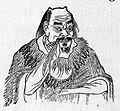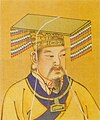Three Sovereigns and Five Emperors
Three Sovereigns and Five Emperors 三皇五帝 | |||||||
|---|---|---|---|---|---|---|---|
| Government | Monarchy | ||||||
| Emperor | |||||||
• c. 2852 – c. 2738 BC | Fuxi | ||||||
• c. 2737 – c. 2638 BC | Shennong | ||||||
• c. 2637 – c. 2598 BC | Yellow Emperor | ||||||
• c. 2597 – c. 2514 BC | Shaohao | ||||||
• c. 2513 – c. 2436 BC | Zhuanxu | ||||||
• c. 2435 – c. 2366 BC | Ku | ||||||
• c. 2365 – c. 2256 BC | Yao | ||||||
• c. 2355 – c. 2206 BC | Shun | ||||||
| |||||||
| Three Sovereigns and Five Emperors | |||||||||||||
|---|---|---|---|---|---|---|---|---|---|---|---|---|---|
| Chinese | 三皇五帝 | ||||||||||||
| |||||||||||||
| Part of a series on the |
| History of China |
|---|
According to Chinese mythology and traditional Chinese historiography, the Three Sovereigns and Five Emperors (Chinese: 三皇五帝; pinyin: Sān huáng wǔ dì) were a series of sage rulers, and the first Emperors of China.[1] Today, they are considered culture heroes,[2] but they were widely worshipped as divine "ancestral spirits" in ancient times. According to received history, the period they existed in preceded the Xia dynasty,[3] although they were thought to exist in later periods to an extent[4] in incorporeal forms that aided the Chinese people, especially with the stories of Nüwa existing as a spirit in the Shang dynasty[5] and Shennong being identified as the godly form of Hou Ji and a founder of the Zhou dynasty.[6]
In myth, the Three Sovereigns were demigods who used their abilities to help create mankind and impart to them essential skills and knowledge. The Five Emperors were exemplary sages who possessed great moral character, and were from a golden age when "communications between the human order and the divine were central to all life" and where the sages embodied the divine, or aided humans in communicating divine forces.[7]
In this period the abdication system was used before Qi of Xia violently seized power and established a hereditary monarchy.[8]
History[edit]
Taoist myths and parables involving shamanistic themes were likely inspired by Tungusic folklore, as were most ancient stories about the Sovereigns Fuxi, Nüwa, and Shennong.[9]
Variations[edit]

There are six to seven known variations on which people constitute the Three Sovereigns and the Five Emperors, depending on the source.[10] Many of the known sources were written in much later dynasties.
Groupings of the Three Sovereigns consist of some combination of the following: Fuxi, Nüwa, Shennong, Suiren, Zhu Rong, Gonggong, the Heavenly Sovereign, the Earthly Sovereign, the Human Sovereign (in two varieties), and the Yellow Emperor.[1]
Groupings of the Five Emperors consist of some combination of the following: the Yellow Emperor, Zhuanxu, Emperor Ku, Emperor Yao, Emperor Shun, Shaohao, Taihao, and the Yan Emperor.
Three Sovereigns[edit]
The Three Sovereigns, sometimes known as the Three August Ones, were said to be god-kings or demigods who used their magical powers, divine powers, or being in harmony with the Tao to improve the lives of their people. Because of their lofty virtue, they lived to a great age and ruled over a period of great peace.
The Sovereigns have elements in common with xian from the Taoist pantheon, such as the Human Sovereign's cloud-chariot and their supernatural abilities. Upon his death, the Yellow Emperor was "said to have become" a xian.[11]
The Yellow Emperor is supposedly the ancestor of the Huaxia people.[12] The Mausoleum of the Yellow Emperor was established in Shaanxi to commemorate the ancestry legend.[12]
The Three Sovereigns are ascribed various identities in different historical texts, as shown in the table below:
| According to source | Three Sovereigns |
|---|---|
| Records of the Grand Historian, addition by Sima Zhen | Heavenly Sovereign, Earthly Sovereign, Tai Sovereign[10] or Fu Xi, Nüwa, Shennong |
| Sovereign series (帝王世系) | Fu Xi, Shennong, Yellow Emperor[10] |
| Shiben | Fu Xi, Shennong, Yellow Emperor[10] |
| Baihu Tongyi (白虎通義) | (1st variation) Fu Xi, Shennong, Zhu Rong[10] (2nd variation) Fu Xi, Shennong, Suiren[10] |
| Fengsu Tongyi | Fu Xi, Nüwa, Shennong[10] |
| Yiwen Leiju | Heavenly Sovereign, Earthly Sovereign; Human Sovereign[10] |
| Tongjian Waiji (通鑑外紀) | Fu Xi, Shennong, Gonggong |
| Chunqiu yundou shu (春秋運斗樞) Chunqiu yuanming bao (春秋元命苞) |
Fu Xi, Nüwa, Shennong |
| Shangshu dazhuan (尚書大傳) | Fu Xi, Shennong, Suiren |
| Diwang shiji (帝王世紀) | Fu Xi, Shennong, Yellow Emperor |
Five Emperors[edit]
The Five Emperors were traditionally thought to have invented "fire, writing and irrigation".[13] Like the Three Sovereigns, they are ascribed different identities depending on historical source, as shown in the table below:
| According to source | Five Emperors |
|---|---|
| Records of the Grand Historian | Yellow Emperor, Zhuanxu, Ku, Yao, Shun[10] |
| Sovereign Series (帝王世紀) | Shaohao, Zhuanxu, Ku, Yao, Shun[10] |
| I Ching | Taihao (太昊), Yan Emperor, Yellow Emperor, Yao, Shun[10] |
| Comments of a Recluse, Qianfulun (潛夫論) | Taihao, Yan, Yellow Emperor, Shaohao, Zhuanxu[14][better source needed] |
| Zizhi tongjian waiji, (資治通鑒外紀) | Yellow Emperor, Shaohao, Zhuanxu, Ku, Yao[14] |
Five Emperors family tree[edit]
| (1) Yellow Emperor[15] | |||||||||||||||||||||||||||||||||||||||||||||||||
| (2) Shaohao | Changyi | ||||||||||||||||||||||||||||||||||||||||||||||||
| Jiaoji | (3) Zhuanxu | ||||||||||||||||||||||||||||||||||||||||||||||||
| (4) Ku | Qiongchan | Sb. | |||||||||||||||||||||||||||||||||||||||||||||||
| (5) Zhi | (6) Yao | Houji | Jingkang 敬康 | Sb. | |||||||||||||||||||||||||||||||||||||||||||||
| Danzhu | Juwang | Sb. | |||||||||||||||||||||||||||||||||||||||||||||||
| {{{罗名[Luoming]}}} | |||||||||||||||||||||||||||||||||||||||||||||||||
| Qiaoniu 橋牛 | Gun | ||||||||||||||||||||||||||||||||||||||||||||||||
| Gusou | (8) Yu | ||||||||||||||||||||||||||||||||||||||||||||||||
| Ehuang | (7) Shun | Nuying | |||||||||||||||||||||||||||||||||||||||||||||||
| Shangjun | |||||||||||||||||||||||||||||||||||||||||||||||||
Creation myth[edit]
There is the legend of the Four Clans (四氏) who took part in creating the world, Youchao-shi (有巢氏), Suiren-shi (燧人氏), Fu Xi-shi (伏羲氏), and Shennong-shi (神農氏).[16]
Legacy[edit]
These Sovereigns and Emperors are said to have helped introduce the use of fire, taught people how to build houses, and invented farming. The Yellow Emperor's wife is credited with the invention of silk culture. The discovery of medicine and invention of the calendar and Chinese script are also credited to the kings. After their era, Yu the Great founded the Xia dynasty, traditionally considered the first dynasty in Chinese historiography.[3]
Gallery[edit]
-
Shennong tasting herbs to discover their qualities
-
Historian's depiction of the Yellow Emperor
-
Another depiction of the Yellow Emperor
References[edit]
- ^ a b "三皇五帝 – 国学网" [Three Sovereigns and Five Emperors – Chinese Studies Network] (in Chinese (China)). 2012-08-16. Retrieved 2023-09-18.
- ^ Hucker, Charles (1995). China's Imperial Past: An Introduction to Chinese History and Culture. Stanford University Press. p. 22. ISBN 978-0-8047-2353-4.
- ^ a b Morton, W. Scott; Lewis, Charlton M. (2005). China: its history and culture (4th ed.). New York: McGraw-Hill. p. 14. ISBN 978-0-07-141279-7.
- ^ Scarpari, Maurizio (2006). Ancient China: Chinese Civilization from the Origins to the Tang Dynasty. Translated by Milan, A.B.A. New York: Barnes & Noble. p. 28. ISBN 978-0-7607-8379-5.
- ^ Ni, Xueting C. (2023). Chinese Myths: From Cosmology and Folklore to Gods and Immortals. London: Amber Books. pp. 76–77. ISBN 978-1-83886-263-3.
- ^ Asim, Ina (2007). "Keynotes 2". University of Oregon. Retrieved 2023-07-18.
- ^ Willard Gurdon Oxtoby, ed. (2002). World Religions: Eastern Traditions (2nd ed.). Don Mills, ON: Oxford University Press. pp. 324, 326. ISBN 0-19-541521-3. OCLC 46661540.
- ^ Feng, Shi (2009) "A Study of the Pottery Inscription 'Wen Yi 文邑'". Chinese Archaeology, Vol. 9 (Issue 1), pp. 170-177. full text
- ^ Palmer, Martin (1999). The Elements of Taoism. United States: Barnes & Noble. p. 15. ISBN 0-7607-1078-3.
- ^ a b c d e f g h i j k 劉煒/著. (2002) Chinese civilization in a new light. Commercial press publishing. ISBN 962-07-5314-3, p. 142.
- ^ "Huangdi". Encyclopedia Britannica. Retrieved 2023-05-22.
- ^ a b Wang, Hengwei (2006) [2005]. 中國歷史講堂 [Chinese history lecture hall] (in Chinese). Zhonghua shuju. p. 13. ISBN 962-8885-24-3.
- ^ Clayre, Alasdair (1985). The Heart of the Dragon (First American ed.). Boston: Houghton Mifflin. p. 37. ISBN 978-0-395-35336-3.
- ^ a b "CHINAKNOWLEDGE", Chinese History - The Three Augusts and Five Emperors 三皇五帝
- ^ Records of the Grand Historian
- ^ Wang 2006, pp. 4–7.
Further reading[edit]
- "Ssŭma Ch'ien's Historical Records, Introductory Chapter". Journal of the Royal Asiatic Society. 26 (2). Translated by Allen, Herbert J.: 269–295 1894. doi:10.1017/S0035869X00143916.
- "The Annals of the Bamboo Books: The reigns of Huang-te, Che, Chuen-heuh and Hëen-Yuen; The reigns of Yaou and Shun". The Chinese Classics, volume 3, part 1. Translated by Legge, James. 1865. pp. 108–116.





